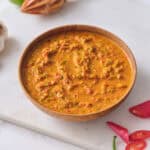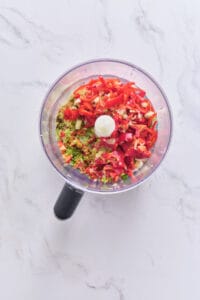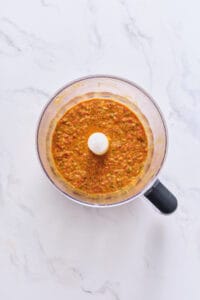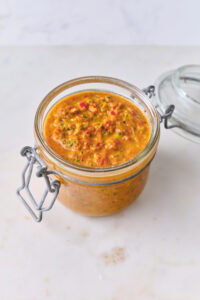Bring bold flavors to your kitchen with this versatile Red Curry Paste—your gateway to vibrant, colorful, and mouthwatering dishes!

If you’re like me and can never seem to find good Thai food in your area, this recipe might just save you lots of time and money wasted on restaurant trial and error. I’ll admit that until recently, I was a wildly picky eater. I’m talking plain chicken and rice, no toppings on my burger, pasta noodles with butter only picky. But in recent years, I’ve ventured out, and I’m so glad I have! Now one of my very favorite cultural cuisines is Thai food, and especially curry.
But good, “true to its roots” Thai food is hard to find where I live. I’ve searched every five-star restaurant, AND every hole in the wall, and not much has impressed me. So I thought, “Why not try and make my own red curry paste right here at home?” And trust me when I tell you, you’re going to want to try it, too.
Curry is a pretty diverse dish. So many different cultures have their own influence and take on it, and there are a variety of curries to try! From classics like Coconut Curry Soup, to seasonal favorites like Pumpkin Curry, you’re bound to find a version of this dish to love.
Red curry paste is made with fresh and colorful ingredients like turmeric, lemongrass, and my personal favorite—red chilies. If you ask me, red chilies are what make this dish. They bring just enough heat, and help color the curry paste a beautiful red-orange hue. Accompanied with aromatic spices, your mouth will be watering before you even know what it tastes like. (Spoiler alert: red curry paste has a luxuriously rich and fiery flavor. If you can handle the heat, you’ll love it.)
Is Red Curry Paste Healthy?
On its own, this red curry paste is a healthy contributor to your dish. While it’s made with fresh ingredients, it’s all about how you use your red curry paste that dictates the healthiness of your meal. I like to use my red curry paste to make a coconut-based chicken curry and serve it over jasmine rice or Coconut Rice for a healthy and easy lunch or dinner.
What Is Curry?
Curry is a term with diverse meanings depending on the culture you’re exploring. In Indian cuisine, curry often refers to a sauce or gravy-based dish flavored with a blend of aromatic spices. In contrast, Thai curry is defined by its use of zingy curry pastes, which form the base for rich, flavorful dishes.
Red curry paste, a hallmark of Thai cuisine, is usually made from a blend of red chilies, garlic, shallots or green onions, lemongrass, galangal, and spices like coriander and cumin. It’s typically cooked with creamy coconut milk to create a bold and balanced sauce that pairs beautifully with proteins like chicken, pork, duck, or tofu, and vegetables.
In Thai cooking, curries are named after the chilies that form the base of their paste: green, yellow, and red. The red curry paste is known for its bold heat and vibrant flavor—and my personal favorite for adding a fiery kick to any dish! Whether you’re making a comforting weeknight dinner or an exotic dish for a special occasion, red curry paste offers an easy way to infuse your cooking with authentic Thai flavors.
INGREDIENTS
- 1 small red bell pepper, seeds removed and diced
- 3 medium red chilies, chopped
- 1 stalk lemongrass (root and tip trimmed), chopped
- 1 1/2 teaspoons ground ginger
- 3 cloves garlic, peeled
- 1 teaspoon ground cumin
- 1 1/4 teaspoons ground turmeric
- 1/2 teaspoon ground coriander
- 1/2 teaspoon ground black pepper
- 1/2 teaspoon kosher salt
- 2 tablespoons lemon juice
- 1 medium lime, zested and juiced
- 5 stalks green onions, sliced
- 1 tablespoon avocado oil
- 2 teaspoons coconut sugar, optional

INSTRUCTIONS
Blend
Combine all ingredients and blend into a paste.
Season
Adjust heat and sweetness to your liking.
Devour!

FAQs & Tips
You can store red curry paste in the fridge for 2 to 3 days, but it will lose its aroma and flavor over time. For longer storage, freeze red curry paste in freezer bags and defrost when you want to cook with it.
The varying colors and flavors of curry paste were originally dependent on the chilies used, but have since been adapted to have more distinct flavors. Red curry paste uses red chilies and is often the spiciest of the varieties. Green curry paste uses cilantro, lime, and basil, and is typically the mildest version of the dish. Yellow curry paste falls somewhere in the middle on the heat scale, and is made with turmeric, which renders its bright color.
Red curry paste is typically smooth and thick, allowing it to blend seamlessly into dishes, especially when combined with coconut milk. Homemade versions might be slightly chunkier if you’re using a standard blender; use a food processor or a high-powered blender for the best results.

Serving Suggestions
You can choose to enjoy your red curry paste in a variety of ways! Make it into a creamy coconut-based curry featuring chicken, shrimp or tofu. Simply follow this Thai Red Curry recipe for full directions.
For more Thai-inspired creations take a look at this Thai Cucumber Salad, these Thai Noodles or this Chicken Pad Thai.


Red Curry Paste
Ingredients
- 1 small red bell pepper seeds removed and diced
- 3 medium red chilies chopped
- 1 stalk lemongrass root and tip trimmed, chopped
- 1 1/2 teaspoons ground ginger
- 3 cloves garlic peeled
- 1 teaspoon ground cumin
- 1 1/4 teaspoons ground turmeric
- 1/2 teaspoon ground coriander
- 1/2 teaspoon ground black pepper
- 1/2 teaspoon kosher salt
- 2 tablespoons lemon juice
- 1 medium lime zested and juiced
- 5 stalks green onions sliced
- 1 tablespoon avocado oil
- 2 teaspoons coconut sugar optional
Instructions
-
Combine all ingredients in a food processor. Blend until a smooth paste forms.

-
Adjust the sweetness and spiciness as needed to fit your preferences.

-
Immediately use in curries, sauces, or other dishes, or store in an airtight container in the fridge.

Nutrition
The post Red Curry Paste appeared first on Food Faith Fitness.





